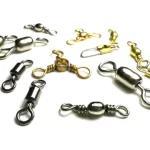Fly fishing can seem overwhelming for beginners, with its array of unfamiliar terms like tippets, leaders, and fly line weights. However, mastering the basics, especially understanding fly rod weights, is crucial for a successful and enjoyable experience. Let’s break down the numbers and help you choose the ideal rod for your fishing adventures.

10+ Weight:
These rods are primarily for saltwater anglers targeting large, powerful species like tarpon and amberjacks. They’re designed to handle heavy streamers and endure lengthy battles with these formidable fish. If you’re new to fly fishing, it’s best to postpone investing in a 10+ weight rod until you’re more experienced and ready for the challenges of saltwater fly fishing.
9 Weight:
This weight class is ideal for targeting steelhead and salmon, and it’s also suitable for many saltwater species. A 9-weight rod can cut through wind effectively and provides the necessary line strength to handle larger, aggressive fish like bonefish and permit in saltwater flats. It’s a valuable addition to any saltwater fly angler’s arsenal.
7-8 Weight:
These versatile rods excel in both freshwater and saltwater environments. They allow for longer casts and can handle larger streamers, making them suitable for muskie and pike. While they may not offer the delicate presentations of lighter rods, they can cast well over 60 feet. An 8-weight rod can even be used for targeting larger fish like steelhead, demonstrating its wide range of applications.
5-6 Weight:
This weight range is highly recommended for beginner fly anglers due to its versatility. It’s suitable for various species, from brown trout to striped bass and largemouth bass. These rods offer a good balance of casting distance and delicate fly presentation, crucial for trout fishing. A 6-weight rod is an excellent tool for learning the fundamentals of fly casting.
2-4 Weight:
These rods are best suited for small, narrow streams and targeting smaller species like sunfish, crappie, and small stream brook trout. They offer a unique and enjoyable fishing experience, as even small fish provide a thrilling fight on these lightweight rods. However, their casting range is limited to about 20 feet.
What You Should Use:
Your choice of fly rod weight depends on the type of fish you’re targeting and the fishing environment. As you progress, you may want to build a collection of rods for various situations. However, if you’re a beginner, starting with a 5-6 weight rod is highly recommended due to its versatility and ease of use.
What the Numbers Mean:
The numbers on a fly rod indicate its weight (“WT”), which corresponds to the appropriate fly line weight. Fly rods also typically display their length and the number of sections they break down into. For example, a “7WT 9′ 4pc” rod is a 7-weight rod, designed for use with a 7-weight line, is 9 feet long, and breaks down into 4 pieces.
Fly rod weights range from 2 to 14, with higher numbers indicating heavier lines, larger flies, and the ability to target larger fish. Conversely, lower numbers are associated with lighter lines, smaller flies, and smaller fish. Fly rod lengths typically range from 7 to 14 feet, with 8’6″ to 9′ being the most common and versatile lengths. Most rods break down into 3 or 4 sections for easy transport.
Getting Started:
Begin with the basics of fly fishing and focus on mastering the fundamentals. Once you’re comfortable, consider exploring other fly rod weights that align with your fishing style and preferences. Remember, fly fishing is a journey of continuous learning and exploration.
Image/Source: WOS





